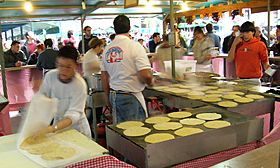Talo (food) facts for kids

|
|
| Type | Bread |
|---|---|
| Place of origin | France and Spain |
| Region or state | Basque Country |
| Main ingredients | Corn flour, water, salt |
Talo is a special food from the Basque Country, a region in both France and Spain. It looks a lot like a corn tortilla, which is a flat, round bread from places like Mexico. Talo is made from corn flour, water, and a little salt.
People cook talo on a hot metal plate called a talo burni, which means "talo iron." You can eat talo by itself, or with different toppings. It's also often used like a wrap to hold other yummy foods inside.
The Story of Talo
Talo became popular in the Basque Country after corn arrived from America around the year 1520. For a long time, talo was a main type of bread for families in Basque homes. Sometimes, if there was any talo left over, people would mix it with milk to make a warm, soup-like meal for dinner.
In the 1900s, wheat bread became more common. This meant people ate less talo every day. Talo then became a special treat, eaten mostly on important days. For example, in cities like Bilbao and Donostia, talo is a must-have at the Saint Thomas' fair, which happens every year on December 21.
Talo for Workers
In the 1930s, workers would often wrap their food inside talo to take with them to the fields. Miners also ate talo during this time. Later, factory workers also enjoyed talo as a quick and easy meal.
How People Eat Talo Today
Today, talo is often eaten with txistorra, which is a thin type of chorizo sausage. People usually enjoy it while drinking txakoli, a local white wine.
Sometimes, talo is served with milk. You can also find it with a fried egg, fried pancetta (called xingar in Basque), or fried Bayonne ham. Other popular toppings include cheese like Ossau-Iraty, chocolate, or honey. If you visit Bayonne, France, during its yearly Bayonne Ham Fair, you'll see street vendors selling talo there.
See also
- In Spanish: Talo (gastronomía) para niños

